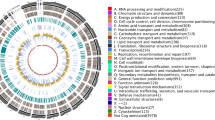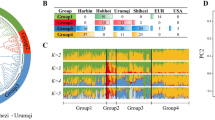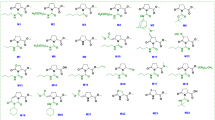Abstract
The plasmid pQBR103 was found within Pseudomonas populations colonizing the leaf and root surfaces of sugar beet plants growing at Wytham, Oxfordshire, UK. At 425 kb it is the largest self-transmissible plasmid yet sequenced from the phytosphere. It is known to enhance the competitive fitness of its host, and parts of the plasmid are known to be actively transcribed in the plant environment. Analysis of the complete sequence of this plasmid predicts a coding sequence (CDS)-rich genome containing 478 CDSs and an exceptional degree of genetic novelty; 80% of predicted coding sequences cannot be ascribed a function and 60% are orphans. Of those to which function could be assigned, 40% bore greatest similarity to sequences from Pseudomonas spp, and the majority of the remainder showed similarity to other γ-proteobacterial genera and plasmids. pQBR103 has identifiable regions presumed responsible for replication and partitioning, but despite being tra+ lacks the full complement of any previously described conjugal transfer functions. The DNA sequence provided few insights into the functional significance of plant-induced transcriptional regions, but suggests that 14% of CDSs may be expressed (11 CDSs with functional annotation and 54 without), further highlighting the ecological importance of these novel CDSs. Comparative analysis indicates that pQBR103 shares significant regions of sequence with other plasmids isolated from sugar beet plants grown at the same geographic location. These plasmid sequences indicate there is more novelty in the mobile DNA pool accessible to phytosphere pseudomonas than is currently appreciated or understood.
Similar content being viewed by others
Log in or create a free account to read this content
Gain free access to this article, as well as selected content from this journal and more on nature.com
or
Accession codes
References
Bailey MJ, Kobayashi N, Lilley AK, Powell BJ, Thompson IP . (1994). Potential for gene transfer in the phytosphere: isolation and characterisation of naturally occurring plasmids. In: Bazin MJ, Lynch JM (eds). Environmental Gene Release. Chapman & Hall: London, UK, pp 77–98.
Bailey MJ, Lilley AK, Diaper JD . (1996). Gene transfer in the phyllosphere. In: Morris CE, Nicot P, Nguyen-the C (eds). Microbiology of Aerial Plant Surfaces. Plenum Publishing: New York, USA, pp 103–123.
Bailey MJ, Rainey PB, Zhang X-X, Lilley AK . (2001). Population dynamics, gene transfer and gene expression in plasmids, the role of the horizontal gene pool in local adaptation at the plant surface. In: Lindow SE, Hecht-Poinar I, Elliott VJ (eds). Microbiology of Aerial Plant Surfaces. American Phytopath. Soc. Press: St Paul, USA, pp 171–189.
Barkay T, Miller SM, Summers AO . (2003). Bacterial mercury resistance from atoms to ecosystems. FEMS Microbiol Rev 27: 355–384.
Bonfield JK, Smith K, Staden R . (1995). A new DNA sequence assembly program. Nucl Acid Res 23: 4992–4999.
Dorman CJ . (2007). H-NS, the genome sentinel. Nat Rev Microbiol 5: 157–161.
Enright AJ, Van Dongen S, Ouzounis CA . (2002). An efficient algorithm for large-scale detection of protein families. Nucl Acid Res 30: 1575–1584.
Field D, Garrity G, Gray T, Morrison N, Selengut J, Sterk P et al. (2007). Towards a richer description of our complete collection of genomes and metagenomes: the ‘Minimum Information about a Genome Sequence’ (MIGS) specification. Nat Biotechnol (in press).
Field D, Wilson G, van der Gast C . (2006). How do we compare hundreds of bacterial genomes? Curr Opin Microbiol 9: 499–504.
Frost LS, Leplae R, Summers AO, Toussaint A . (2005). Mobile genetic elements: the agents of open source evolution. Nat Rev Microbiol 3: 722–732.
Gal M, Preston GM, Massey RC, Spiers AJ, Rainey PB . (2003). Genes encoding a cellulosic polymer contribute toward the ecological success of Pseudomonas fluorescens SBW25 on plant surfaces. Mol Ecol 12: 3109–3121.
Galibert F, Finan TM, Long SR, Puhler A, Abola P, Ampe F et al. (2001). The composite genome of the legume symbiont Sinorhizobium meliloti. Science 293: 668–672.
Galperin MY, Koonin EV . (2004). ‘Conserved hypothetical’ proteins: prioritization of targets for experimental study. Nucl Acid Res 32: 5452–5463.
Gonzalez V, Santamaria RI, Bustos P, Hernandez-Gonzalez I, Medrano-Soto A, Moreno-Hagelsieb G et al. (2006). The partitioned Rhizobium etli genome: genetic and metabolic redundancy in seven interacting replicons. Proc Natl Acad Sci USA 103: 3834–3839.
Greated A, Lambertsen L, Williams PA, Thomas CM . (2002). Complete sequence of the IncP-9 TOL plasmid pWW0 from Pseudomonas putida. Environ Microbiol 4: 856–871.
Hayes F, Barilla D . (2006). The bacterial segrosome: a dynamic nucleoprotein machine for DNA trafficking and segregation. Nat Rev Microbiol 4: 133–143.
Kobayashi N, Bailey MJ . (1994). Plasmids isolated from the sugar beet phyllosphere show little or no homology to molecular probes currently available for plasmid typing. Microbiol 140: 289–296.
Kurtz S, Choudhuri JV, Ohlebusch E, Schleiermacher C, Stoye J, Giegerich R . (2001). REPuter: the manifold applications of repeat analysis on a genomic scale. Nucl Acid Res 29: 4633–4642.
Lilley AK, Bailey MJ . (1997a). The acquisition of indigenous plasmids by a genetically marked pseudomonad population colonizing the sugar beet phytosphere is related to local environmental conditions. Appl Environ Microbiol 63: 1577–1583.
Lilley AK, Bailey MJ . (1997b). Impact of plasmid pQBR103 acquisition and carriage on the phytosphere fitness of Pseudomonas fluorescens SBW25: burden and benefit. Appl Environ Microbiol 63: 1584–1587.
Lilley AK, Bailey MJ, Barr M, Kilshaw K, Timms-Wilson TM, Day MJ et al. (2003). Population dynamics and gene transfer in genetically modified bacteria in a model microcosm. Mol Ecol 12: 3097–3107.
Lilley AK, Bailey MJ, Day MJ, Fry J . (1996). Diversity of mercury resistance plasmids obtained by exogenous isolation from the bacteria of sugar beet in three successive seasons. FEMS Microbiol Ecol 20: 211–228.
Lilley AK, Fry JC, Day MJ, Bailey MJ . (1994). In situ transfer of an exogenously isolated plasmid between indigenous donor and recipient Pseudomonad spp in sugar beet rhizosphere. Microbiol 140: 27–33.
Llanes C, Gabant P, Couturier M, Michel-Briand Y . (1994). Cloning and characterization of the Inc A/C plasmid RA1 replicon. J Bacteriol 176: 3403–3407.
Lowe TM, Eddy SR . (1997). tRNAscan-SE: a program for improved detection of transfer RNA genes in genomic sequence. Nucl Acid Res 25: 955–964.
Maeda K, Nojiri H, Shintani M, Yoshida T, Habe H, Omori T . (2003). Complete nucleotide sequence of carbazole/dioxin-degrading plasmid pCAR1 in Pseudomonas resinovorans strain CA10 indicates its mosaicity and the presence of large catabolic transposon Tn4676. J Mol Biol 326: 21–33.
Mark GL, Dow JM, Kiely PD, Higgins H, Haynes J, Baysse C et al. (2005). Transcriptome profiling of bacterial responses to root exudates identifies genes involved in microbe-plant interactions. Proc Natl Acad Sci USA 102: 17454–17459.
Martiny JBH, Field D . (2005). Ecological perspectives on the sequenced genome collection. Ecol Lett 8: 1334–1345.
McAllister CF, Stephens DS . (1993). Analysis in Neisseria meningitidis and other Neisseria species of genes homologous to the FKBP immunophilin family. Mol Microbiol 10: 13–23.
McKenna S, Beloin C, Dorman CJ . (2003). In vitro DNA-binding properties of VirB, the Shigella flexneri virulence regulatory protein. FEBS Lett 545: 183–187.
Medini D, Donati C, Tettelin H, Masignani V, Rappuoli R . (2005). The microbial pan-genome. Curr Opin Genet Dev 15: 589–594.
Miller RV, Levy SB . (1989). Horizontal gene transfer in relation to environmental release of genetically engineered microorganisms. In: Levy SB, Miller RV (eds). Gene Transfer in the Environment. McGraw-Hill Publishing Company: New York, USA, pp 405–420.
Mindlin S, Minakhin L, Petrova M, Kholodii G, Minakhina S, Gorlenko Z et al. (2005). Present-day mercury resistance transposons are common in bacteria preserved in permafrost grounds since the upper pleistocene. Res Microbiol 156: 994–1004.
Molbak L, Tett A, Ussery DW, Wall K, Turner S, Bailey M et al. (2003). The plasmid genome database. Microbiology 149: 3043–3045.
Ochman H, Lawrence JG, Groisman EA . (2000). Lateral gene transfer and the nature of bacterial innovation. Nature 405: 299–304.
Osborn AM, Boltner D . (2002). When phage, plasmids, and transposons collide: genomic islands, and conjugative- and mobilizable-transposons as a mosaic continuum. Plasmid 48: 202–212.
Overbeek R, Begley T, Butler RM, Choudhuri JV, Chuang HY, Cohoon M et al. (2005). The subsystems approach to genome annotation and its use in the project to annotate 1000 genomes. Nucl Acid Res 33: 5691–5702.
Peabody CR, Chung YJ, Yen MR, Vidal-Ingigliardi D, Pugsley AP, Saier MH . (2003). Type II protein secretion and its relationship to bacterial type IV pili and archaeal flagella. Microbiology 149: 3051–3072.
Powell BJ, Purdy KJ, Thompson IP, Bailey MJ . (1993). Demonstration of tra+ plasmid activity in bacteria indigenous to the phyllosphere of sugar beet; gene transfer to a genetically modified pseudomonad. FEMS Microbiol Ecol 12: 195–206.
Rainey PB . (1999). Adaptation of Pseudomonas fluorescens to the plant rhizosphere. Environ Microbiol 1: 243–257.
Rodriguez-Valera F . (2002). Approaches to prokaryotic biodiversity: a population genetics perspective. Environ Microbiol 4: 628–633.
Rutherford K, Parkhill J, Crook J, Horsnell T, Rice P, Rajandream MA et al. (2000). Artemis: sequence visualization and annotation. Bioinformatics 16: 944–945.
Schroder G, Lanka E . (2005). The mating pair formation system of conjugative plasmids – a versatile secretion machinery for transfer of proteins and DNA. Plasmid 54: 1–25.
Silby MW, Levy SB . (2004). Use of in vivo expression technology to identify genes important in growth and survival of Pseudomonas fluorescens Pf0-1 in soil: discovery of expressed sequences with novel genetic organization. J Bacteriol 186: 7411–7419.
Smalla K, Krogerrecklenfort E, Heuer H, Dejonghe W, Top E, Osborn M et al. (2000). PCR-based detection of mobile genetic elements in total community DNA. Microbiology 146: 1256–1257.
Snyder LA, Jarvis SA, Saunders NJ . (2005). Complete and variant forms of the ‘gonococcal genetic island’ in Neisseria meningitidis. Microbiology 151: 4005–4013.
Sulakhe D, Rodriguez A, D’Souza M, Wilde M, Nefedova V, Foster I . (2005). GNARE: automated system for high-throughput genome analysis with grid computational backend. J Clin Monit Comput 19: 361–369.
Sundin GW, Murillo J . (1999). Functional analysis of the Pseudomonas syringae rulAB determinant in tolerance to ultraviolet B (290–320 nm) radiation and distribution of rulAB among P. syringae pathovars. Environ Microbiol 1: 75–87.
Tark M, Tover A, Tarassova K, Tegova R, Kivi G, Horak R et al. (2005). A DNA polymerase V homologue encoded by TOL plasmid pWW0 confers evolutionary fitness on Pseudomonas putida under conditions of environmental stress. J Bacteriol 187: 5203–5213.
Tendeng C, Soutourina OA, Danchin A, Bertin PN . (2003). MvaT proteins in Pseudomonas spp.: a novel class of H-NS-like proteins. Microbiology 149: 3047–3049.
Tobes R, Pareja E . (2006). Bacterial repetitive extragenic palindromic sequences are DNA targets for insertion sequence elements. BMC Genomics 7: 62.
Turner SL, Lilley AK, Bailey MJ . (2002). Ecological and molecular maintenance strategies of mobile genetic elements. FEMS Microbiol Ecol 42: 209–215.
Van Elsas J, Turner S, Bailey MJ . (2003). Horizontal gene transfer in the phytosphere. New Phytologist 157: 525–537.
Viegas CA, Lilley AK, Bruce K, Bailey MJ . (1997). Description of a novel plasmid replicative origin from a genetically distinct family of conjugative plasmids associated with phytosphere microflora. FEMS Microbiol Lett 149: 121–127.
Zhang XX, Lilley AK, Bailey MJ, Rainey PB . (2004a). The indigenous Pseudomonas plasmid pQBR103 encodes plant-inducible genes, including three putative helicases. FEMS Microbiol Ecol 51: 9–17.
Zhang XX, Lilley AK, Bailey MJ, Rainey PB . (2004b). Functional and phylogenetic analysis of a plant-inducible oligoribonuclease (orn) gene from an indigenous Pseudomonas plasmid. Microbiology 150: 2889–2898.
Acknowledgements
We thank G Wilson and C Ekeke for their help in the analysis of the pQBR103 sequence and Bela Tiwari for consultation on the microarray analysis. AT was funded by a UK NERC studentship. The sequencing of pQBR103 was funded via a UK BBSRC grant (P16729) to PR and CT. The unpublished P. fluorescens Pf0-1 and SBW25 genomes were accessed from the USA DOE Joint Genome Institute and the UK Wellcome Trust Sanger Institute, respectively.
Author information
Authors and Affiliations
Corresponding author
Additional information
Supplementary Information accompanies the paper on The ISME Journal website (http://www.nature.com/ismej)
Supplementary information
Rights and permissions
About this article
Cite this article
Tett, A., Spiers, A., Crossman, L. et al. Sequence-based analysis of pQBR103; a representative of a unique, transfer-proficient mega plasmid resident in the microbial community of sugar beet. ISME J 1, 331–340 (2007). https://doi.org/10.1038/ismej.2007.47
Received:
Revised:
Accepted:
Published:
Issue date:
DOI: https://doi.org/10.1038/ismej.2007.47
Keywords
This article is cited by
-
Complete sequence and comparative genomic analysis of eight native Pseudomonas syringae plasmids belonging to the pPT23A family
BMC Genomics (2017)
-
Determining the Effects of a Spatially Heterogeneous Selection Pressure on Bacterial Population Structure at the Sub-millimetre Scale
Microbial Ecology (2010)
-
Plasmids captured in C. metallidurans CH34: defining the PromA family of broad-host-range plasmids
Antonie van Leeuwenhoek (2009)



